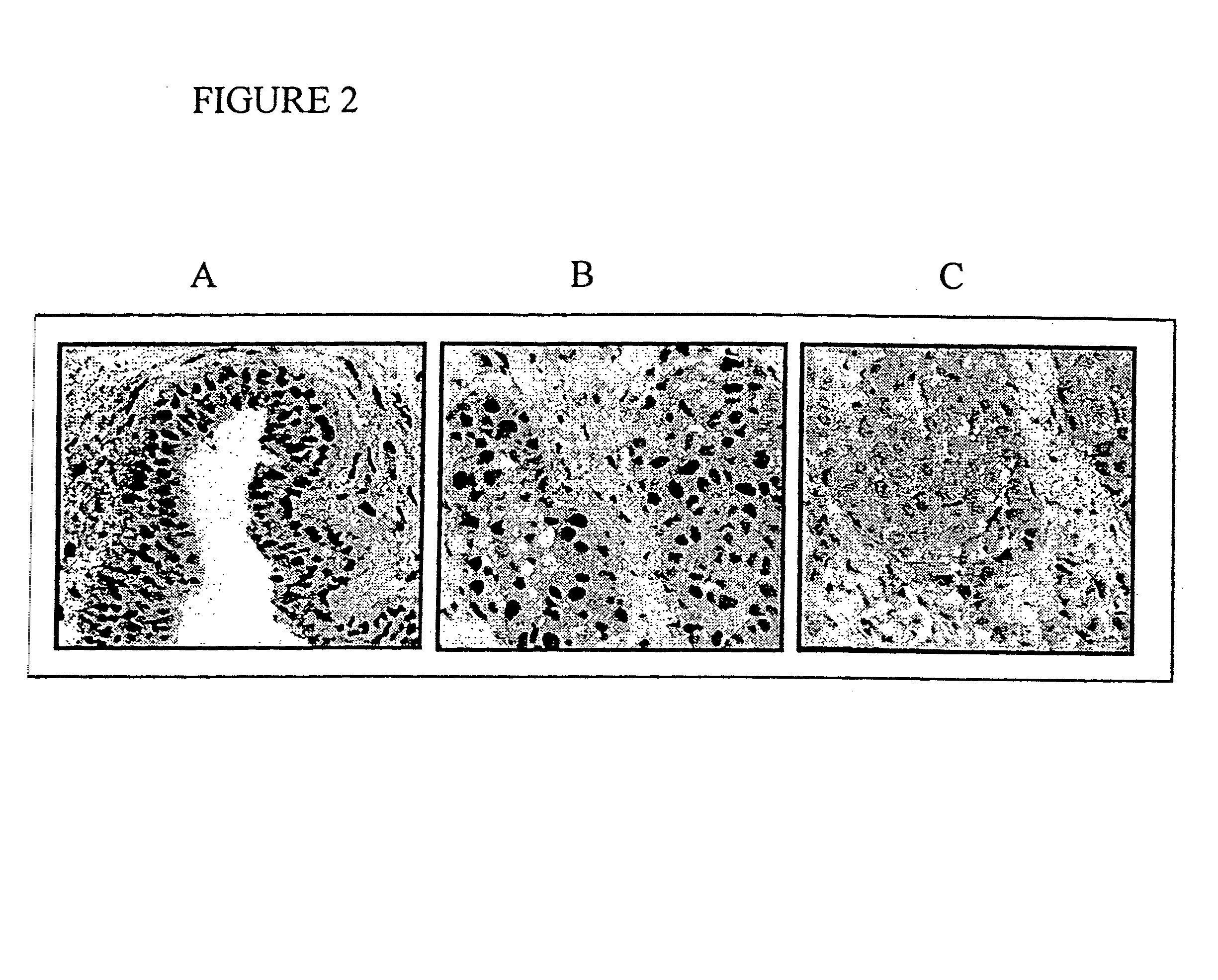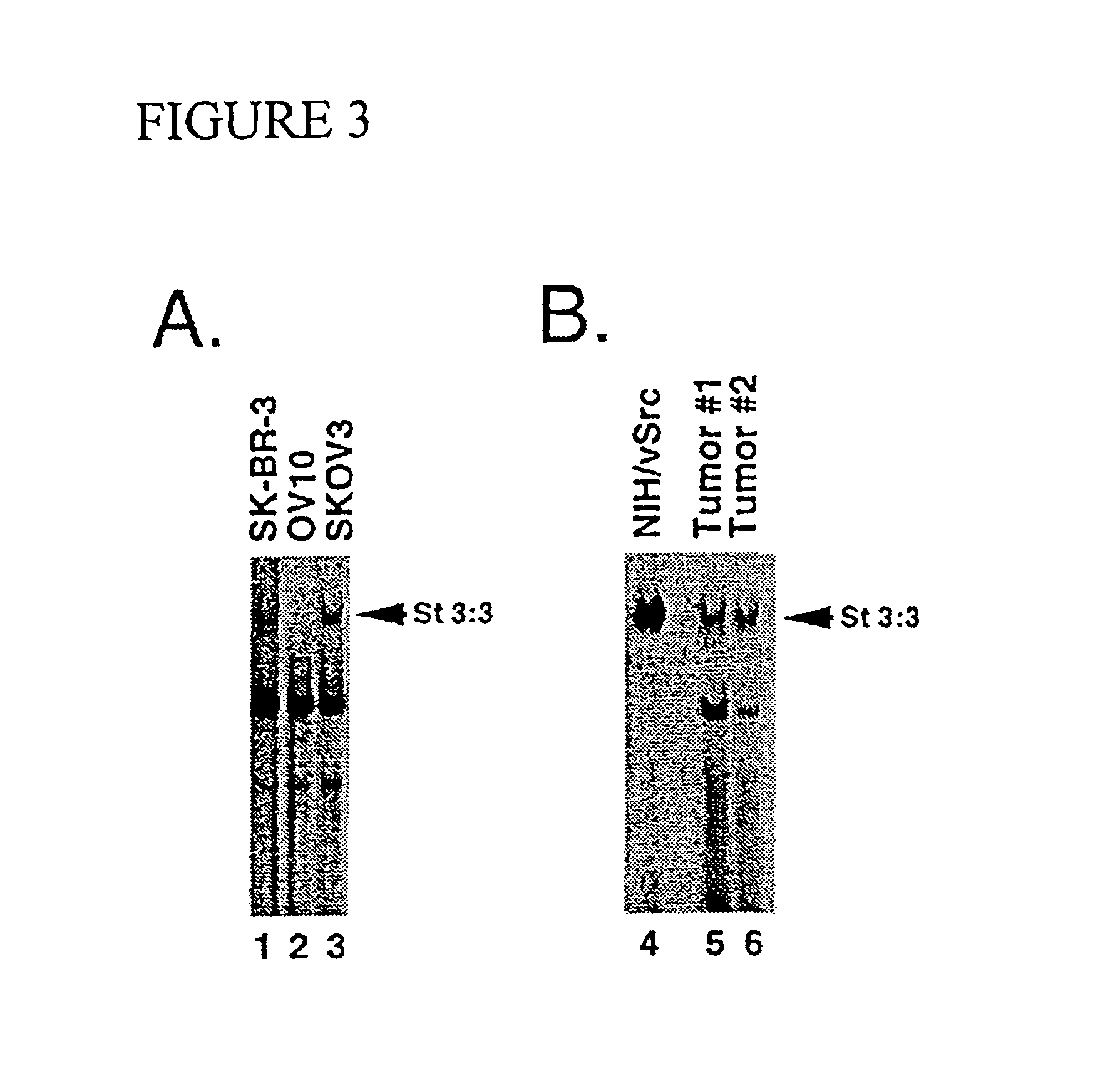Inhibition of STAT3 signal transduction for human cancer therapy
a technology of stat3 signal transduction and human cancer, which is applied in the direction of depsipeptides, peptide/protein ingredients, fungi, etc., to achieve the effects of enhancing the effectiveness of chemotherapeutic agents, preventing tumor formation, and facilitating tumor formation
- Summary
- Abstract
- Description
- Claims
- Application Information
AI Technical Summary
Benefits of technology
Problems solved by technology
Method used
Image
Examples
example 1
Constitutive Activation of STAT3 in Breast Carcinoma Cell Lines
[0067]In this first example, we show that STAT3 is selectively and constitutively activated in many breast carcinoma cell lines, but not three cell lines derived from normal breast tissue. This example shows that disruption of STAT3 signaling is a desirable aspect of the present invention in the prevention of the growth of cancer cells. STAT DNA-binding activity in human breast cancer cell lines is examined by electrophoretic mobility shift assays (EMSA) (Garcia et al., 1997, Cell Growth Diff. 8:1267-1276). In these experiments, EMSAs are performed using the 32P-labeled sis-inducible element (SIE) as a probe to detect STAT DNA-binding activity in nuclear extracts of cells. This synthetic DNA oligonucleotide probe is a high-affinity mutant of the c-fos SIE, called hSIE, that binds both STAT1 and STAT3 (Yu, et al., 1995, Science 269:81-83). Our analysis reveals that STAT3, but not STAT1, is strikingly activated in five of ...
example 2
STAT Activation in Primary Breast Tumor Specimens
[0068]The second example demonstrates that constitutive activation of STAT3 is further present in primary breast tumor specimens, and is not limited to cells grown in suspension. In the present invention, this example provides further evidence of the desirability of inhibiting STAT3 signaling to inhibit cancer cell growth. As shown, tumor specimens snap frozen within 15 minutes of surgical excision retain the original STAT activation profile present at the time of excision (FIG. 1A). Using this procedure, increased STAT3 DNA-binding activity is detected in 5 out of 6 primary (stage III) breast tumors examined compared to adjacent non-tumor tissue (FIGS. 1A and B). An immunohistochemical assay for STAT3 activation based on the use of antibodies to activated, tyrosine phosphorylated STAT3 (pY-Stat3) is developed. With this assay, high levels of activated, nuclear pY-Stat3 are detected in the tumor cells, but not in the surrounding non-t...
example 3
Constitutive Activation of STAT3 in Ovarian Cancer Cell Lines and Tumors
[0069]The third example further demonstrates that constitutive activation of STAT3 is present in ovarian cancer cells. In the present invention, this example provides additional evidence of the 5 desirability of inhibiting STAT3 signaling to inhibit cancer cell growth. EMSA analyses of ovarian tumor specimens from patients are performed. As shown in FIG. 3B, primary ovarian tumors have constitutively-elevated STAT3 DNA binding activity. Moreover, the model human ovarian cancer cell line, SKOV3, but not OV10, also exhibits constitutively elevated STAT3 activation (FIG. 3A). These findings indicate that constitutive STAT3 activation is not limited 10 to breast carcinoma but, rather, is a feature in common with other solid tumors.
PUM
| Property | Measurement | Unit |
|---|---|---|
| pH | aaaaa | aaaaa |
| final volume | aaaaa | aaaaa |
| length | aaaaa | aaaaa |
Abstract
Description
Claims
Application Information
 Login to View More
Login to View More - R&D
- Intellectual Property
- Life Sciences
- Materials
- Tech Scout
- Unparalleled Data Quality
- Higher Quality Content
- 60% Fewer Hallucinations
Browse by: Latest US Patents, China's latest patents, Technical Efficacy Thesaurus, Application Domain, Technology Topic, Popular Technical Reports.
© 2025 PatSnap. All rights reserved.Legal|Privacy policy|Modern Slavery Act Transparency Statement|Sitemap|About US| Contact US: help@patsnap.com



